Nearing ten o’clock at night. Speeding through customs with a small, carry-on backpack to a waiting taxi. Luxury!
Well before eleven we round a corner warmed by the glowing windows of the William Pub to arrive at Akademi Hotellet.
Opening the door of our third floor room we step straight into a vision. Two steeples of the cathedral alight against the inky blackness of night. Stars of many colours ascending to heaven. Lasers lancing dark clouds.
Bags dumped, we gleefully retrace our steps and head for the William. An English pub Swede-ified.
Mellow lights. A rumble of conversation. No music.
A hipster pours us a Guinness and a glass of red wine. We sit in the window, taking in the sights.
A pile of dirty snow – and de facto bike rack. The cathedral’s mesmerising lights. Pavement grit, sparkling.
We sleep well. Don’t hear the bells marking the passing hours. Or the long peal greeting six in the morning, when the world’s still immersed in night.
Downstairs, the dining room’s warm and welcoming.
Tea lights glimmer on tables, pendant lights in windows.
A buffet of many delights awaits: boiled eggs, meats, pickles. Jams, cheeses, breads.
Tiny smoothies, violet speckled with blackberry-blue. Each a mouthful of jewel-like richness.
White yogurt, ladled with scarlet lingonberries. Like fresh snow dotted with bright holly berries – but edible.
Well-breakfasted, the prof heads off to Uppsala’s university, to meet a group of geneticists. A joint project, many moons in the planning.
For me, a day of lone discovery.
Preparing for this trip was odd. I had no worries, no anxieties. Most unlike me.
Somehow I knew. All would be well.
The cathedral, my first stop, detains me several hours.
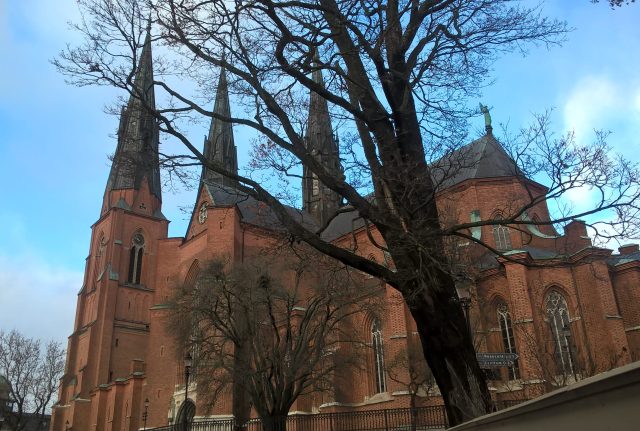
Building began in c 1270, it was consecrated in 1435 but in the great fire of Uppsala in 1702 extensive damage was done. At the end of the 19th c major restoration works resulted in the spires, paintings and stained glass of today. It’s the largest church in the Nordic countries, 118 m high and long.
I see the memorial to 12th century king and saint, Erik the Holy. It was believed he was murdered by the Danish on the site where the cathedral now stands.
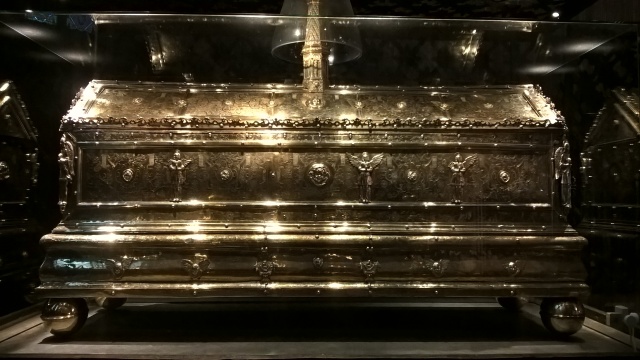
Sumptuous repository from 1580 for the relics of King Erik, Sweden’s patron saint who was killed in c 1160 on the site where the cathedral now stands
Another monument, somewhat obscured by chairs (preparations for a professorial inauguration are underway), celebrates Carl Linnaeus.
There’s even a side chapel named after a chancellor of the university, Johan Skytte (1577-1645).
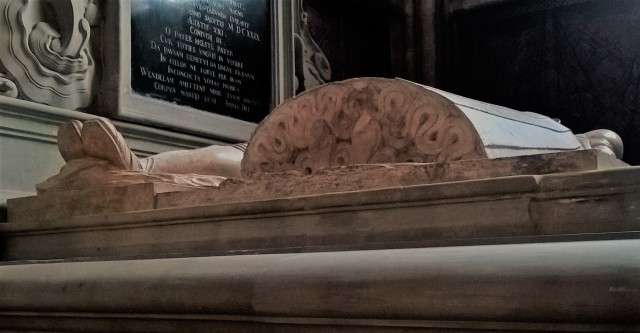
Look at her skirt all ruffles! And her shoes hidden in there. Never seen one like this. She is Vendela Skytte (maiden name, daughter of the chancellor) renowned for her learning. She died of the plague with her newborn daughter in 1629 aged 21.
Particularly touching for me, with his links to Zambia and Barbara Hepworth, is Dag Hammarskjöld’s memorial.

“Not I, but God in me” He was killed in Zambia in 1961 when his plane crashed – rumours persist that it was shot down. He was on his way, as UN Secretary General, to negotiate a cease fire in a conflict in the Congo. He was awarded a rare posthumous Nobel Peace prize.
In the chapel for silent prayer I sit, thinking.
Two young men enter. One tousled blonde, the other neatly dark.
The tousled one confounds my expectations, kneeling, praying, writing in the guest book.
He leaves.
His friend kneels in turn, head bowed, concentrating. Writes at length in the book. Prays some more before leaving.
I kneel. Send my hopes and fears up through the roof, into the winter sky.
Curiosity impels me to read what the young man wrote, in English – plainly not his native tongue.
It’s a plea for peace in the world.
Humbled, I pen a short echo and leave, warmed by the spirit of youth.
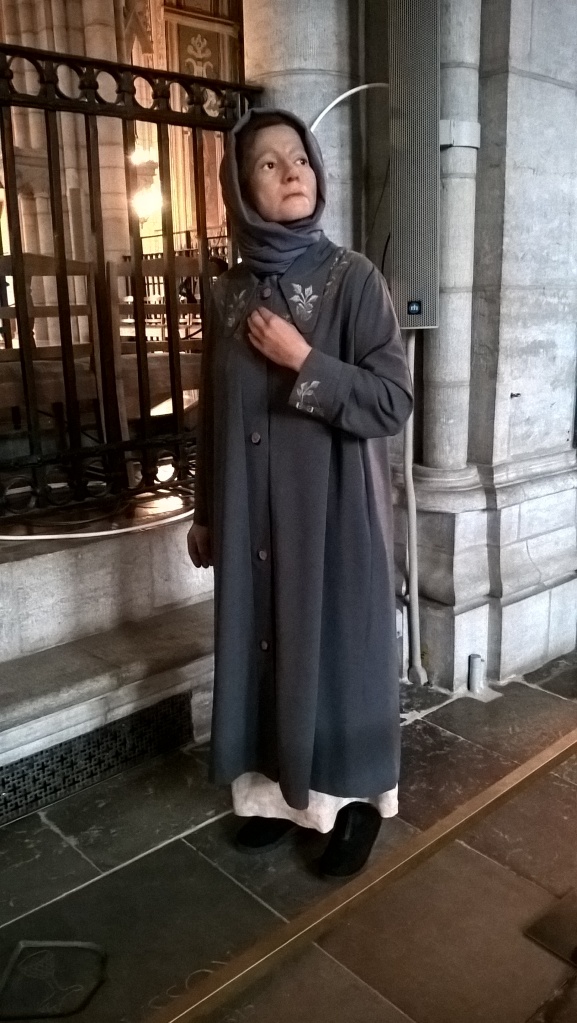
I stood a while, hesitating to walk past this woman, eventually realising it was a statue – it is incredibly realistic. The piece is called ‘Mary (the return)’ by Anders Widroff. His aim was apparently to portray the mother of Jesus as herself, independently of Jesus and someone we would recognise as a person like ourselves
Taking the lift up the tower to the seventh floor I gawp at a medieval dress and other ancient textiles.
Back down on earth I realise I’m hungry and make my way downhill to the shops.
I enter one selling special teas – in packets, not to drink. The young man behind the counter chats in perfect English. Swedish by birth, son of Eritrean parents, he recommends a falafel van round the corner.
I’m too cold for that and brave a tiny café down a side street. Order an avocado ciabatta. Tea – black leaves, dotted with blue – is served in an infuser dunked in a mug of hot water.
I wander the shopping streets, amble along the riverbank.
A window display of Moomins lures me into a toyshop. I buy a plastic Moomin plate. The woman, roughly my age, remarks, in halting English, that though we learned to love Moomins as children, age doesn’t lessen their appeal. She’s right.
Light fading, I tromp back uphill, hesitate, then try the door of a church which looks as if it’s closed.

Holy Trinity church built during the 14th c and consecrated in 1343. The cupola and weathervane were put up after the great fire of Uppsala in 1702.

The partly (see base) granite church was first mentioned in 1302 and to distinguish it from its near neighbour, the cathedral, it was called Bondkyrko – the peasants’ church.
In the porch, I stand, stunned by faded scraps of paintings adorning walls and ceiling.
It’s the famine before the feast.
For the next hour I look, walk around, sit. Spellbound. And alone.
Like everywhere I’ve been it’s warm.
Brass chandeliers emit a mellow light. Candles burn.
It’s easy, here, to see how important paintings would have been to illiterate church goers. One has a special resonance for me, a child born on Holy Innocents’ Day. But I’ll let the images speak for themselves.
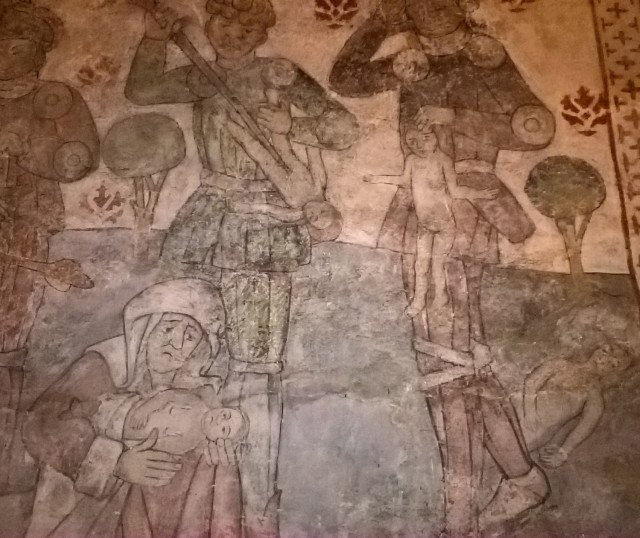
Herod orders the slaughter of all male children under three years of age – an event remembered by the Catholic Church on 28 December
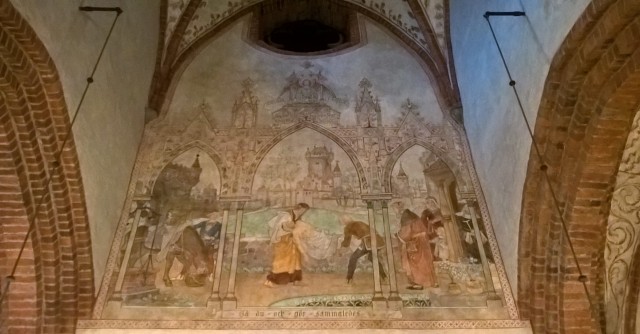
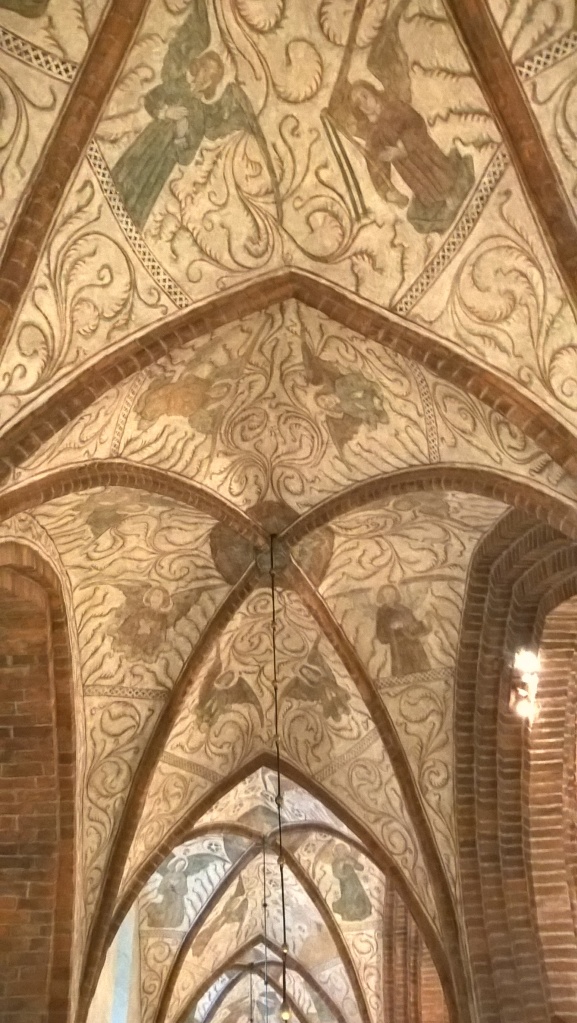
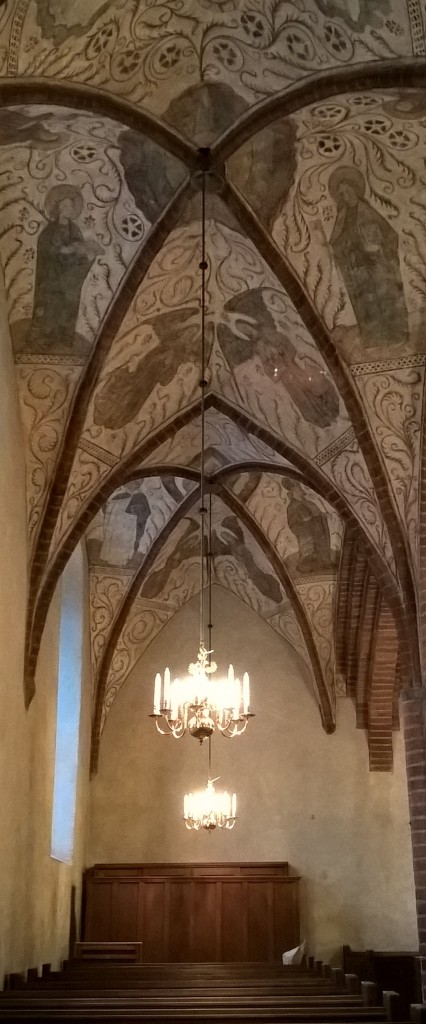
 In the evening, we’re treated to an Italian meal by the prof’s academic colleagues. Around the table are seven of us, of seven nationalities.
In the evening, we’re treated to an Italian meal by the prof’s academic colleagues. Around the table are seven of us, of seven nationalities.
By the time we leave my brain’s abuzz. As if it’s been reconditioned. For one who works alone, it’s a rare treat.
Next day the prof and I are free to be tourists together and visit ‘my’ church.
The cathedral’s closed for the professorial inauguration. A disappointment soon eclipsed by the castle.

The peachy shape in the trees is the castle. Originally built in the 16th c it was the site of the Sture murders by another King Erik (not a saint). Dag Hammarskjöld lived some of his early life here as his father, Uppland Governor, resided there – it now also houses an art museum and fab cafe! The castle was severely damaged in the great fire of 1702 and much of what is seen now is renovation.
We marvel at the University’s precious silver bible. Written in the Gothic language, in the sixth century, on purple tinted parchment in silver and gold ink, it’s now on Unesco’s Memory of the World register. We see some awesome paper treasures – 700 year old books, maps and pictures. (Imagine 700 year old data sticks in a display case?)
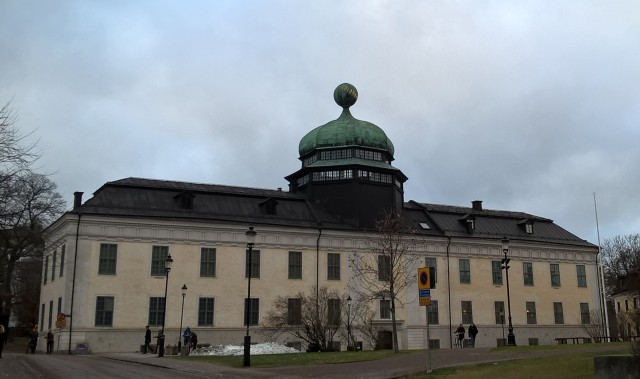
The University Museum. At the top is the original dissecting theatre – designed for light to flood down onto the action and also designed so that anyone who fell asleep or fainted would be wedged in their narrow slot in the seating and not fall! I was told about this and aim to see it next time… Two days was not enough.
It strikes me that education – learning – is valued here.
Yes, Uppsala’s an ancient university city. But the hoardings round building sites don’t boast of financial investment, or facilities, they celebrate Nobel prize-winners.
Admittedly, in this land of Abba, ‘money, money, money’ is a bit of an issue for us Brexit-burdened-Brits. Things are expensive, especially now the pound is weak.
But think on this, all ye who hate paying tax.
Signs outside the library and the castle tell us (in English) all the people of Sweden pay for the upkeep of these national assets – because it’s their national heritage.
There’s an additional charge on the fare for public transport into the airport – to help repay the costs incurred in upgrading the infrastructure.
That’s what taxes do. They pay for the things we all need, or care about, or treasure.
Or arguably should.
So I suppose the question is, what do we treasure?
Well, I treasure the memories of this visit. Well worth the airfare and my half of the hotel bill.
Thank you, Uppsala. It was wonderful.
See you again, soon. I hope.

This may seem rather an odd picture to include, but in my wanderings I cam across this huge cemetery right there between the shopping/tourist side and the university – it’s obviously well used as a thoroughfare – another path dissects it too – but this one and the woman in the distance reminded me for some reason of my favourite (probably) film, The Third Man. The woman walking away at the end. Cue the music…

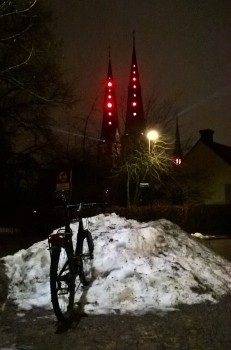


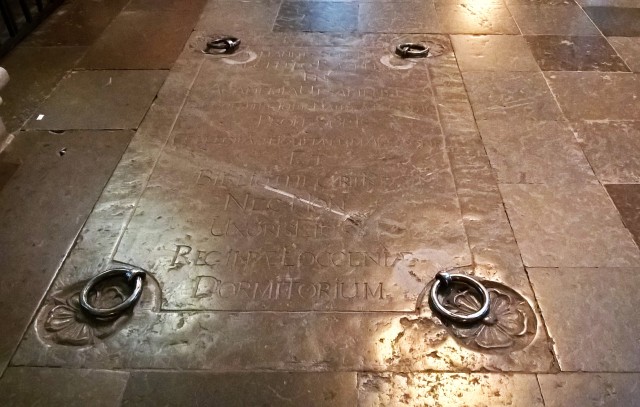




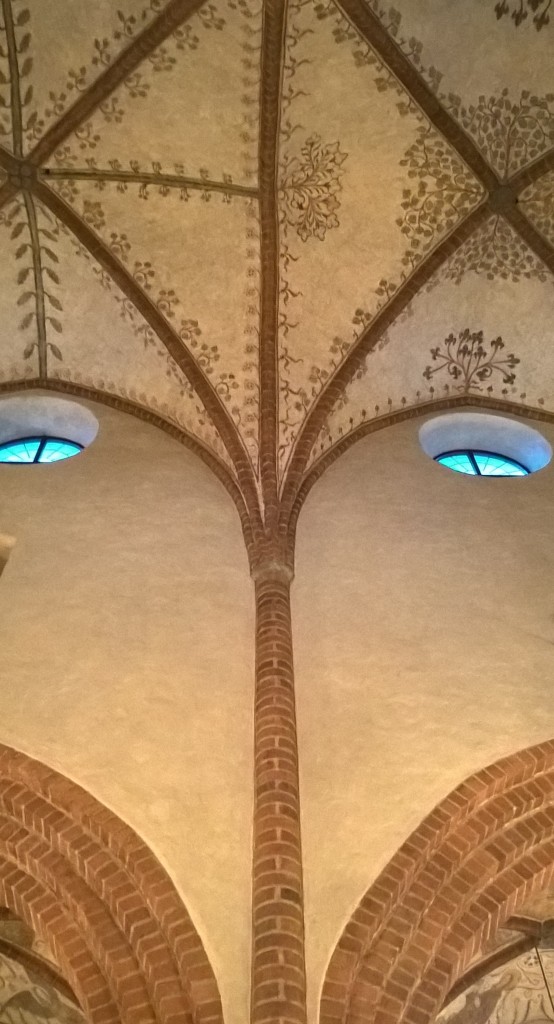
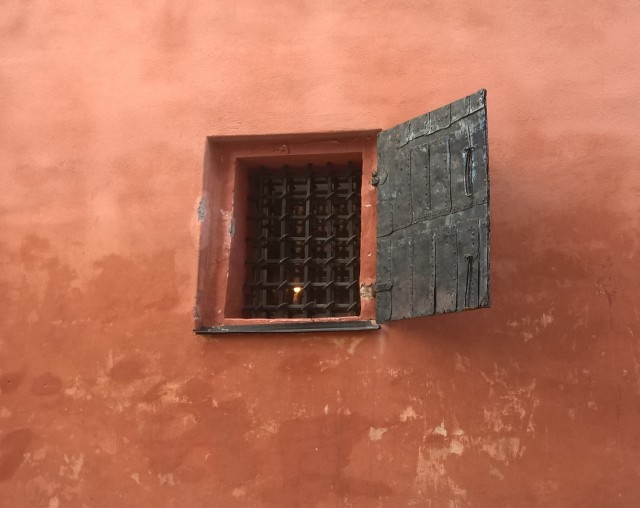

Sounds a refreshing and hopeful break for you .,beautiful churches ,especially the second one
Holy Trinity.
LikeLike
It was terrific. The muse was very, very glad of the break. Let’s hope she’s back to stay… And since I’ve come back revivified I’ve also organised a roofer for a new leak 😦 an electrician to replace 12 square spotlights and three hexagonal ones we inherited with round ones (they no longer make them)and had the central heating serviced. This won’t seem like much to you I’m sure but since I hate doing this kind of stuff, even picking up the phone to organise it makes me grind my teeth and grumble, that is an amazing roll call of achievement! 😉 Yes, the painted church was beautiful and tranquil and all round wonderful. x
LikeLike
Sounds like a really interesting trip. Love the paintings in Holy Trinity!
LikeLike
It was fab. And they were beautiful! I have to buy a camera for next time… Look forward to benefitting from your advice!
LikeLike
The decorations seem to be predominantly on the ceiling. And the tree of life picture has two blue eyes looking down. What a nice getaway!
LikeLike
The ones about the nativity were on the wall, but most of the ones on the wall were in dark light unfortunately. But the ones on the ceiling were beautiful. It was wonderful. Amazing how 3 nights/2 days can be as refreshing as a two week holiday (which is just as well – we totted it up the other day – in all our years together we’ve had only 6 ‘real’ holidays!!!)
LikeLike
Welcome back! Glad you had a great mini-vacation. Love these pictures!
LikeLike
Thanks! You too 🙂 Yes the sights were fab, just wish I’d had a camera instead of my phone…
LikeLiked by 1 person
I love your travel writing! You have such a brilliant eye for detail and the bigger picture! Inspiring! Love Alison
LikeLike
Alison how nice of you! Good to hear from you and hope you are well. I absolutely loved Uppsala and can’t wait to go back there… but it’s 3 nights in Poland next!
LikeLike
Pingback: Death, burial – and untimely resurrection | MEMOIRS OF A HUSK